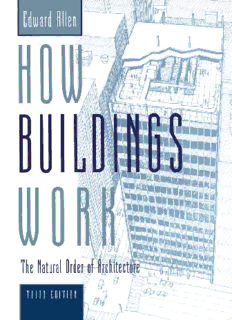
How Buildings Work: The Natural Order of Architecture PDF
Preview How Buildings Work: The Natural Order of Architecture
How Buildings Work This page intentionally left blank How Buildings Work THE NATURAL ORDER OF ARCHITECTURE Third Edition EDWARD ALLEN Drawings by David Swoboda and Edward Allen OXFORD UNIVERSITY PRESS 2OO5 OXJORD UNIVERSITY PRESS Oxford University Press, Inc., publishes works that further Oxford University's objective of excellence in research, scholarship, and education. Oxford New York Auckland Cape Town Dar es Salaam Hong Kong Karachi Kuala Lumpur Madrid Melbourne Mexico City Nairobi New Delhi Shanghai Taipei Toronto With offices in Argentina Austria Brazil Chile Czech Republic France Greece Guatemala Hungary Italy Japan Poland Portugal Singapore South Korea Switzerland Thailand Turkey Ukraine Vietnam Copyright © 1980,1995, 2005 by Oxford University Press, Inc. Published by Oxford University Press, Inc. 198 Madison Avenue, New York, New York 10016 www.oup.com Oxford is a registered trademark of Oxford University Press All rights reserved. No part of this publication may be reproduced, stored in a retrieval system, or transmitted, in any form or by any means, electronic, mechanical, photocopying, recording, or otherwise, without the prior permission of Oxford University Press. Library of Congress Cataloging-in-Publication Data Allen, Edward. How buildings work : the natural order of architecture / Edward Allen. —3rd ed. p. cm. Includes bibliographical references and index. Cover title: Natural order of architecture. ISBN-13: 978-0-19-516198-4 ISBN-io: o-i9-5i6i98-X i. Buildings—Environmental engineering. I. Title: Natural order of architecture. II. Title. TH6o2i.A44 2004 721—dc22 2004021414 9 8 7 6 5 4 3 21 Printed in the United States of America on acid-free paper With thanks to the people who helped make it happen: JOYCE BERRY NOEL CARR ALBERT G. H. DIETZ ELLEN R. FUCHS N. J. HABRAKEN CATHERINE HUMPHRIES FRANK JONES DONLYN LYNDON DOUGLAS MAHONE JAMES RAIMES ELDA ROTOR J. N. TARN CYBELE TOM WACLAW ZALEWSKI and especially MARY M. ALLEN This page intentionally left blank Prexace to the Tnird Edition Over the past quarter century, the practice of building has under- gone significant changes in several areas, notably mechanical, elec- trical, and communications systems. Researchers have added to our knowledge of building function. New areas of social concern have emerged, especially for buildings that are accessible by all, and for building in a sustainable manner. This third edition, in the tradition of its predecessors, sticks to the basics, but includes hundreds of changes both large and small that reflect the current state of the art and science of building. I have retained the basic organization of the original volume, along with its look and feel, all of which have worn well. The mission and premise of the book remain unchanged. South Natick, Massachusetts January 2005 This page intentionally left blank Contents Prologue: Sustainable Building, x WHAT BUILDINGS DO 1. The Outdoor Environment, 3 2. The Human Environment, 15 3. The Concept of Shelter, 23 HOW BUILDINGS WORK 4. Building Function, 31 5. Providing Water, 33 6. Recycling Wastes, 41 7. Providing for Thermal Comfort, 49 8. Thermal Properties of Building Components, 53 9. Controlling the Radiation of Heat, 72 10. Controlling Air Temperature and Humidity, 81 11. Controlling Air Movement, 99 12. Keeping Water Out, 109 13. Seeing and Illumination, 128 14. Hearing and Being Heard, 138 15. Providing Concentrated Energy, 149 16. Fitting Buildings to People, 158 17. Providing Structural Support, 172 18. Providing for Building Movement, 204 19. Controlling Fire, 213 20. Getting a Building Built, 227 21. Keeping a Building Alive and Growing, 239 22. Building Components and Building Function, 252 Glossary, 257 Index, 267
Description: